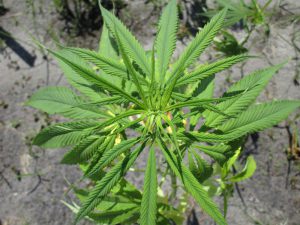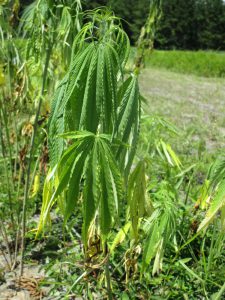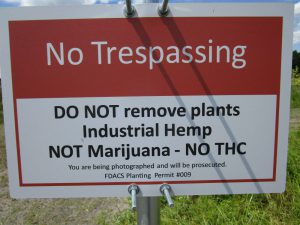“When can we grow it legally?”
“What cultivars should I grow in Florida?”
“How are we going to process it?”
“Can I make money growing Industrial Hemp?”
Update of FDACS Legislation on Industrial Hemp
There are so many questions about this ancient crop that is now legal and being introduced to Florida. The Director of Cannabis with the Florida Department of Agriculture and Consumer Services (FDACS), Ms. Holly Bell, answered dozens of questions from approximately 100 local growers in the Tri-County Agriculture Area (TCAA) at the Putnam County Agriculture Center on July 29, 2019 regarding Industrial Hemp. Industrial Hemp is a close cousin to marijuana as they both come from the Cannabis sativa family, but Industrial Hemp has no more than 0.3% (dry matter basis) of the mind-altering component known as THC. So you can basically smoke it all day long and simply end up with a headache. FDACS will regulate the crop and they are currently in the rule-making process. Ms. Bell projected that farmers interested in growing this crop will be able to apply for an annual permit starting around October of 2019. She also suggested that it would take less than 30 days to get approved for a permit. All applicants will have to get fingerprinted and have a background check done to ensure that they have not been a convicted felon of narcotics within the last 10 years. As part of the permit stipulations, growers will have to obtain certified seed to grow the crop. Additionally, FDACS inspectors will have to be notified within 30 days of the crop harvest in order to oversee sampling activities to prove the crop contains 0.3% THC or less on a dry matter basis. These samples will be sent by farmers to an ISO certified lab to measure concentrations of THC. If the crops shows concentrations in excess of 0.3% THC, further analyses will be completed by FDACS and if confirmed, it will likely have to be destroyed.
Industrial Hemp Characteristics

UF/IFAS hosted their first Industrial Hemp Workshop and Field Day in Gainesville on July 30, 2019, and several of the same faces from the TCAA were present at this workshop. Dr. Zack Brym discussed the plant physiology and explained that Industrial Hemp is annual, herbaceous, and diecious (meaning that there are both male and female plants). There are essentially three major variety types depending on the end use – some varieties are for producing fiber, others for grain, and the most popular is for CBD (Cannabidiol which is an extracted oil used for medicinal purposes). The fiber varieties produce tall fibrous stalks that can be processed into rope, bioplastics, paper, hempcrete, etc. The CBD varieties are a smaller, bushy plant that produces flowers from which the CBD extraction occurs. Zack explained that female plants containing virgin flowers (i.e. those that have not been pollinated from male plants) are required for CBD production. Holly described the potential pitfalls associated with pollen drift that could cause cross-contamination of CBD varieties with fiber varieties, and so potential buffer zones will need to be considered as part of the policy-making strategies. Currently, the major money making market for Industrial Hemp is with the production of CBD. Holly estimated that it would cost growers around $15,000 to $20,000 per acre to grow; however, a profit margin of $15,000 to $20,000 per acre could be expected if the crop had good genetics and produced high quality CBD (i.e. 14% CBD).
Challenges with Industrial Hemp
There are many challenges associated with growing Industrial Hemp in Florida. The first challenge is where to obtain quality certified seed. For the UF Pilot Project, certified clean seed was difficult to obtain. Some of the seed imported by UF was contaminated with hemp aphids and some of the imported cuttings were contaminated with hemp russet mites, which are two pests not currently present in Florida. The material had to be quarantined and so only certain varieties could be used in the Statewide trials. The second challenge is with controlling pests. There are currently no EPA registered pesticides that are labelled for use on Industrial Hemp. Although soaps, oils and non-restricted use pesticides can be applied, the efficacy these products is very limited. The third challenge for Florida is light availability. Hemp performs best with long photoperiods of 12 to 14 hours of daylight. However, Florida summers do not have lengthy photoperiods relative to other prolific Hemp growing areas such as Colorado and Canada. Finally, Industrial Hemp looks, smells and tastes just like Marijuana, so if some curious onlookers see the crop growing in the field they may be tempted to remove it illegally. Thus, clear signage and protective fencing will be necessary to avoid unwanted visitors.
UF Pilot Project Near Gainesville
At the UF Workshop in Gainesville, Dr. John Erikson provided a field tour of the Hemp Pilot Project at the UF Forage Unit in Hague (just north of Gainesville). Other outdoor plantings include those at UF research facilities in Homestead, Quincy, Apopka, and Bivens Arm (Gainesville). In Hague, a variety trial including 25 different cultivars – 4 CBD varieties, 4 fiber varieties, 3 grain varieties, and 14 grain/fiber combination varieties – were planted on May 28, 2019. The certified seed for these varieties were imported from all over the world, but primarily Colorado, Canada, Italy and China. The disadvantage of this site is that it contains poorly drained sandy soil and the crop remained saturated after heavy rain events in the last couple weeks. One clear observation from this location is that Industrial Hemp does not like wet feet. Only about 50% of the seed actually emerged and growth was extremely stunted due to excessive moisture. The consensus is that Industrial Hemp in Florida should be grown on raised beds, ideally using plastic mulch to protect from pests and disease. The plants in Homestead are planted on well-drained sandy soils and are performing much better. UF has not yet established a recommended fertility program for Industrial Hemp but the current consensus on nitrogen requirements is three split applications of 150 kgN/ha (134lbN/A). UF has two full years from May 1, 2019 to complete their pilot project and provide recommendations to commercial growers interested in growing Industrial Hemp in Florida. Those seriously interested in growing the crop are visiting successful operations in Colorado and contracting consultants that have extensive experience growing Industrial Hemp. But the fact remains that Florida with its heat, humidity and excessive pest pressure is a whole new environment for Industrial Hemp and the existing genetics may not fit the bill. It will be interesting to see what comes of all the hype.



 0
0

